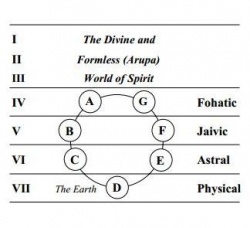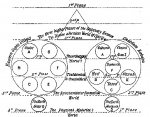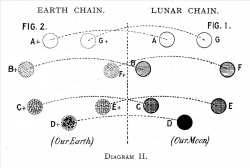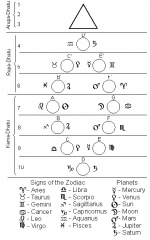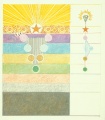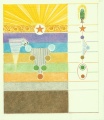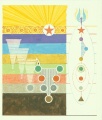Planetary Chain: Difference between revisions
| Line 1: | Line 1: | ||
== Planetary Chains == | == Planetary Chains == | ||
The word "planetary chain" refers to a group of seven "[[globe]]s", "spheres", or "planets" linked together in a single scheme of evolution. | The word "planetary chain" refers to a group of seven "[[globe]]s", "spheres", or "planets" linked together in a single scheme of evolution. | ||
| Line 6: | Line 6: | ||
<blockquote>The life and evolutionary processes of this planet . . . are linked with the life and evolutionary processes of several other planets. . . . One globe does not afford Nature scope for the processes by which mankind has been evoked from chaos, but these processes do not require more than a limited and definite number of globes. Separated as these are, in regard to the gross mechanical matter of which they consist, they are closely and intimately bound together by subtle currents and forces, whose existence reason need not be much troubled to concede, since the existence of some connection - of force or ethereal media - uniting all visible celestial bodies, is proved by the mere fact that they are visible. It is along these subtle currents that the life elements pass from world to world.<ref>Alfred Percy Sinnett, ''Esoteric Buddhism'' (London: The Theosophical Publishing House Ltd, 1972), 29.</ref></blockquote> | <blockquote>The life and evolutionary processes of this planet . . . are linked with the life and evolutionary processes of several other planets. . . . One globe does not afford Nature scope for the processes by which mankind has been evoked from chaos, but these processes do not require more than a limited and definite number of globes. Separated as these are, in regard to the gross mechanical matter of which they consist, they are closely and intimately bound together by subtle currents and forces, whose existence reason need not be much troubled to concede, since the existence of some connection - of force or ethereal media - uniting all visible celestial bodies, is proved by the mere fact that they are visible. It is along these subtle currents that the life elements pass from world to world.<ref>Alfred Percy Sinnett, ''Esoteric Buddhism'' (London: The Theosophical Publishing House Ltd, 1972), 29.</ref></blockquote> | ||
[[File:Chains and Rounds.JPG|right|250px]] | |||
These globes are not all on the same [[plane]] of perception. In the words of [[Koot Hoomi|Mahatma K. H.]]: | These globes are not all on the same [[plane]] of perception. In the words of [[Koot Hoomi|Mahatma K. H.]]: | ||
Revision as of 16:47, 6 August 2012
Planetary Chains
The word "planetary chain" refers to a group of seven "globes", "spheres", or "planets" linked together in a single scheme of evolution.
This concept was published for the first time in 1883 by Alfred Percy Sinnett in his book Esoteric Buddhism. He wrote:
The life and evolutionary processes of this planet . . . are linked with the life and evolutionary processes of several other planets. . . . One globe does not afford Nature scope for the processes by which mankind has been evoked from chaos, but these processes do not require more than a limited and definite number of globes. Separated as these are, in regard to the gross mechanical matter of which they consist, they are closely and intimately bound together by subtle currents and forces, whose existence reason need not be much troubled to concede, since the existence of some connection - of force or ethereal media - uniting all visible celestial bodies, is proved by the mere fact that they are visible. It is along these subtle currents that the life elements pass from world to world.[1]
These globes are not all on the same plane of perception. In the words of Mahatma K. H.:
Now, the congeries of the star-worlds (including our own planet) inhabited by intelligent beings may be likened to an orb or rather an epicycloid formed of rings like a chain — worlds inter-linked together, the totality representing an imaginary endless ring, or circle.[2]
This chain of worlds is formed by seven globes on different planes of perception. H. P. Blavatsky explains:
The one eternal LAW unfolds everything in the (to be) manifested Nature on a sevenfold principle; among the rest, the countless circular chains of worlds, composed of seven globes, graduated on the four lower planes of the world of formation (the three others belonging to the Archetypal Universe). Out of these seven only one, the lowest and the most material of those globes, is within our plane or means of perception, the six others lying outside of it and being therefore invisible to the terrestrial eye. Every such chain of worlds is the progeny and creation of another, lower, and dead chain—its reincarnation, so to say.[3]
In the Theosophical literature the two highest globes are denominated A and G (or Z) on the descending and ascending arcs respectively. The globes on the next lower plane are B and F, the next pair are denominated C and E, and the lowest of all is the glob D.
Planetary Chain and the Tree of Life
Controversy about Mars and Mercury
In his correspondence with the Mahatmas K. H. and M., Mr. Sinnett asked the following question:
What other planets of those known to ordinary science, besides Mercury, belong to our system of worlds?
Are the more spiritual planets — (A, B & Y, Z) — visible bodies in the sky or are all those known to astronomy of the more material sort?[4]
The answer from Mahatma K.H. was the following:
Mars and four other planets of which astronomy knows yet nothing. Neither A, B, nor Y, Z, are known; nor can they be seen through physical means however perfected.[5]
From this, Mr. Sinnett naturally assumed that Mars, Mercury, and the Earth where all part of the same septenary chain of globes, as he published in his Esoteric Buddhism:
Besides the earth, which is at the lowest material point, there are only two other worlds of our chain which are visible to physical eyes--the one behind and the one in advance of it. These two worlds, as a matter of fact, are Mars and Mercury--Mars being behind and Mercury in advance of us--Mars in a state of entire obscuration now as regards the human life-wave, Mercury just beginning to prepare for its next human period. . . . The two planets of our chain that are behind Mars, and the two that are in advance of Mercury, are not composed of an order of matter which telescopes can take cognizance of. Four out of the seven are thus of an ethereal nature, which people who can only conceive matter in its earthly form will be inclined to call immaterial. But they are not really immaterial at all.[6]
However, in The Secret Doctrine, H. P. Blavatsky wrote that this notion was an error:
This was a great mistake. But the blame for it is to be attached as much to the vagueness and incompleteness of the Master’s answer as to the question of the learner itself, which was equally vague and indefinite.
It was asked: “What planets, of those known to ordinary science, besides Mercury, belong to our system of worlds?” Now if by “System of Worlds” our terrestrial chain or “string” was intended in the mind of the querist, instead of the “Solar System of Worlds,” as it should have been, then of course the answer was likely to be misunderstood. For the reply was: “Mars, etc., and four other planets of which astronomy knows nothing. Neither A, B, nor YZ are known nor can they be seen through physical means however perfected.” As to Mars, Mercury, and “the four other planets,” they bear a relation to Earth of which no master or high Occultist will ever speak, much less explain the nature . . . But neither Mars nor Mercury belong to our chain. They are, along with the other planets, septenary Units in the great host of “chains” of our system, and all are as visible as their upper globes are invisible.[7]
It is not clear what relation these planets bear to Earth.
Annie Besant's intepretation
In 1895 Annie Besant was asked about this matter. Her answer was as follows:
The facts are these; the planetary chain consists of Globes A., B., Mars, Earth, Mercury, F., and G., and round these the great life-wave has swept three and a half times, reaching Earth for the fourth time; the mass of humanity passed from Mars to the Earth, and will pass from the Earth to Mercury. But the leading class of humanity — and here is a fact that throws some light on the opposing statements — did not share in this general evolution. It came directly to the Earth from another region at a much later period in evolution, and had never been on Mars at all. Another fact, which H.P.B. evidently had in mind, when writing on this question, is that Mars is also concerned in an entirely different evolution, as to which nothing can be publicly said. It is therefore impossible to clear the matter up to the satisfaction of exoteric students, but it is just that it should be publicly stated that Mr. Sinnett's statement is entirely borne out by the original letter.[8]
Annie Besant, C. W. Leadbeater and C. Jinarajadasa continued to maintain that Mars and Mercury are part of the earth chain[9] while other Theosophists such as W. Q. Judge and Robert Crosbie regarded them as the globe D of different chains. G. de Purucker also maintained this position, although he introduced five more globes to the planetary chains, thus making them consist of 12 globes.
G. de Purucker's interpretation
In his work The Twelve Sacred Planets, David Pratt presents G. de Purucker's view in the following way:
He points out that ‘our system of worlds’ can refer to our universal solar system (i.e. all the solar systems revolving around the same raja-sun as our own), our planetary chain, our group of seven sacred planets, and to ‘this mystery-group – Earth, Mercury, Mars, and four other secret planets’. KH’s generalized reply refers in particular to this latter group, because Sinnett had just been questioning KH ‘on a certain aspect of the teachings which could not be fully explained without giving out the doctrine concerning this mystery-group’.
GdeP explains that many planetary chains in our solar system and universal solar system have no globes on our own plane of perception. All the countless planetary chains, visible and invisible, are divided into families of seven (or twelve), whose members are closely related karmically.11 Referring to our own sacred planets, he writes:
[The] seven sacred planets are profoundly instrumental in building our planetary chain; but the earth also itself is one of another group or series of seven planets, which build or cooperate in building the planetary chain of certain other ones of our planets...
Earth, Mercury, Mars, and the four secret planets are a septenary group ‘whose function is to act in building another planetary chain’.
Our own planetary chain helps to build and guide one of the other planetary chains in particular but all the other planetary chains of our solar system in general. Mars, for example, is built by its particular group of seven or twelve planetary chains, itself being the eighth of its ogdoad, and our Earth chain is one of these. Not all of the seven sacred planets of any of the planets in our solar system would necessary be our own sacred planets.
Referring to the twelve sacred planets, GdeP writes:
We thus have the seven planetary chains, two of which are invisible, respectively Vulcan and the sacred planet named in connection with the moon; and there are four other invisible planetary chains mentioned in The Mahatma Letters (p. 176) under the mere letters ‘A, B, and Y, Z.’ These four, with the seven enumerated, make eleven, to which we may add the solar chain, forming the full number of twelve. These planetary chains are those which especially recognize our sun as their ruler, and therefore they form the main members of its kingdom.
GdeP’s inclusion of the solar chain in the preceding quotation may be a blind, since KH includes the Earth in the ‘mystery group’ of planets that include A, B, Y, and Z. This is supported by GdeP’s statement that ‘the fields of action of the spiritual monad are our solar system, particularly the seven sacred planets and our earth as well as four other “secret” planetary chains’. He also writes:
There are only twelve sacred planets for us in the solar system. The sun is our common Chief. [T]his is the secret why Jesus had twelve disciples while he himself was the thirteenth or teacher.[10]
Rebirth of a new chain
In The Secret Doctrine Mme. Blavatsky explains the following:
These globes are formed by a process which the Occultists call the “rebirth of planetary chains (or rings).” When the seventh and last of one of such rings has been entered upon, the highest or first globe “A,” followed by all the others down to the last, instead of entering upon a certain time of rest—or “obscuration,” as in their previous Rounds—begins to die out. The “planetary” dissolution (pralaya) is at hand, and its hour has struck; each globe has to transfer its life and energy to another planet.[11]
Teachings of Annie Besant and C. W. Leadbeater
Teachings of G. de Purucker
In his Occult Glossary, G. de Purucker explains the following:
Every kosmic body or globe, be it sun or planet, nebula or comet, atom or electron, is a composite entity formed of or comprised of inner and invisible energies and substances and of an outer, to us, and often visible, to us, physical vehicle or body. These elements all together number seven (or twelve), being what is called in theosophy the seven principles or elements of every self-contained entity; in other words, of every individual life-center.
Thus every one of the physical globes that we see scattered over the fields of space is accompanied by six invisible and superior globes, forming what in theosophy is called a chain. This is the case with every sun or star, with every planet, and with every moon of every planet. It is likewise the case with the nebulae and the comets as above stated: all are septiform entities, all have a sevenfold constitution, even as man has, who is a copy in the little of what the universe is in the great, there being for us one life in that universe, one natural system of "laws" in that universe. Every entity in the universe is an inseparable part of it; therefore what is in the whole is in every part, because the part cannot contain anything that the whole does not contain, the part cannot be greater than the whole.
Our own earth-chain is composed of seven (or twelve) globes, of which only one, our earth, is visible on this our earth plane to our physical sense apparatus, because that apparatus is builded or rather evolved to cognize this earth plane and none other. But the populations of all the seven (or twelve) globes of this earth-chain pass in succession, and following each other, from globe to globe, thus gaining experience of energy and matter and consciousness on all the various planes and spheres that this chain comprises.
The other six (or eleven) globes of our earth-chain are invisible to our physical sense, of course; and, limiting our explanation only to the manifest seven globes of the complete chain of twelve globes, the six globes other and higher than the earth exist two by two, on three planes of the solar system superior to our physical plane where our earth-globe is — this our earth. These three superior planes or worlds are each one superior to the world or plane immediately beneath or inferior to it.
Our earth-globe is the fourth and lowest of all the manifest seven globes of our earth-chain. Three globes precede it on the descending or shadowy arc, and three globes follow it on the ascending or luminous arc of evolution. The Secret Doctrine by H. P. Blavatsky and the more recent work, Fundamentals of the Esoteric Philosophy (1932), contain most suggestive material for the student interested in this phase of the esoteric philosophy.[12]
Artistic representations
Theosophist James S. Perkins, in his book Visual Meditations on the Universe[13] publishes five original paintings representing the evolution of the "Earth Scheme" inspired by the teachings of Annie Besant and C. W. Leadbeater on the subject.
The horizontal colored bars represent the planes as follows:
- Purple: atmic plane
- Light blue: buddhic plane
- Yellow: higher mental plane
- Green: lower mental plane
- Orange: astral plane
- Grey: etheric plane
- Brown: physical dense plane
Notes
- ↑ Alfred Percy Sinnett, Esoteric Buddhism (London: The Theosophical Publishing House Ltd, 1972), 29.
- ↑ Vicente Hao Chin, Jr. Mahatma Letters to A. P. Sinnett in chronological sequence No. 18 (Quezon City: Theosophical Publishing House, 1993), 64.
- ↑ Helena Petrovna Blavatsky, The Secret Doctrine vol. I (London: The Theosohpical Publishing House, 1978), 152.
- ↑ Vicente Hao Chin, Jr. Mahatma Letters to A.P. Sinnett in chronological sequence No. 93A (Quezon City: Theosophical Publishing House, 1993), 307
- ↑ Vicente Hao Chin, Jr. Mahatma Letters to A.P. Sinnett in chronological sequence No. 93B (Quezon City: Theosophical Publishing House, 1993),331
- ↑ Alfred Percy Sinnett, Esoteric Buddhism (London: The Theosophical Publishing Hourse LTD, 1972), 136-137.
- ↑ Helena Petrovna Blavatsky, Secret Doctrine vol. I, (Wheaton, Ill: Theosophical Publishing House, 1993), 163
- ↑ Annie Besant, Lucifer Vol. XVII, No. 100 (London: Theosophical Publishing Society, December 1895), 271.
- ↑ Annie Besant and Charles Webster Leadbeater, Man: Whence How and Whither A Record of Clairvoyant Investigation (Adyar: The Theosophical Publishing House, 1913), 4
- ↑ Mars/Mercury controversy by David Pratt, 2007
- ↑ Helena Petrovna Blavatsky, The Secret Doctrine vol. I (London: The Theosohpical Publishing House, 1978), 159
- ↑ Gottfried de Purucker, Occult Glossary (Pasadena, CA: Theosophical University Press, 1996), 129.
- ↑ James S. Perkins, Visual Meditations on the Universe (Wheaton, IL:Theosophical Publishing House, 1984), 128 pp.
Further reading
- Planetary Chain at Theosopedia
